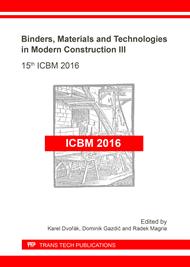p.51
p.56
p.63
p.71
p.76
p.83
p.88
p.94
p.100
Slurry Infiltrated Fibre Concrete with Waste Steel Fibres from Tires - The Behaviour under Static and Dynamic Load
Abstract:
Waste fibres coming from the recycling process of the old tires were incorporated in slurry infiltrated fibre concrete (SIFCON), which is a special type of high performance fibre reinforced concrete with high fibre content. The technological feasibility (i.e. suitability of the waste fibres for SIFCON technology) was assessed using infiltration test and homogeneity test. Test specimens were prepared with three volume fractions (5; 7.5 and 10% by vol.) of waste unclassified fibres. SIFCON with industrial steel fibres (10% by vol.) and high performance fibre concrete with industrial fibres were also cast and tested for comparison purposes. Quasi-static mechanical properties were determined. The impact test was carried out by using an in-house manufactured impact testing machine based on drop test principle. Realized tests confirmed the possibility of using the waste fibres for SIFCON technology. The obtained results indicate, that the usage of waste fibres does not significantly reduce the values of SIFCON flexural and compressive strength at quasi-static load and energy absorption at dynamic load, the values were comparable to the specimens with industrially produced fibres. With increasing fibre content, the mechanical parameters and energy-absorption characteristics at dynamic load are increasing as well.
Info:
Periodical:
Pages:
76-82
Citation:
Online since:
October 2017
Authors:
Price:
Сopyright:
© 2017 Trans Tech Publications Ltd. All Rights Reserved
Share:
Citation:


